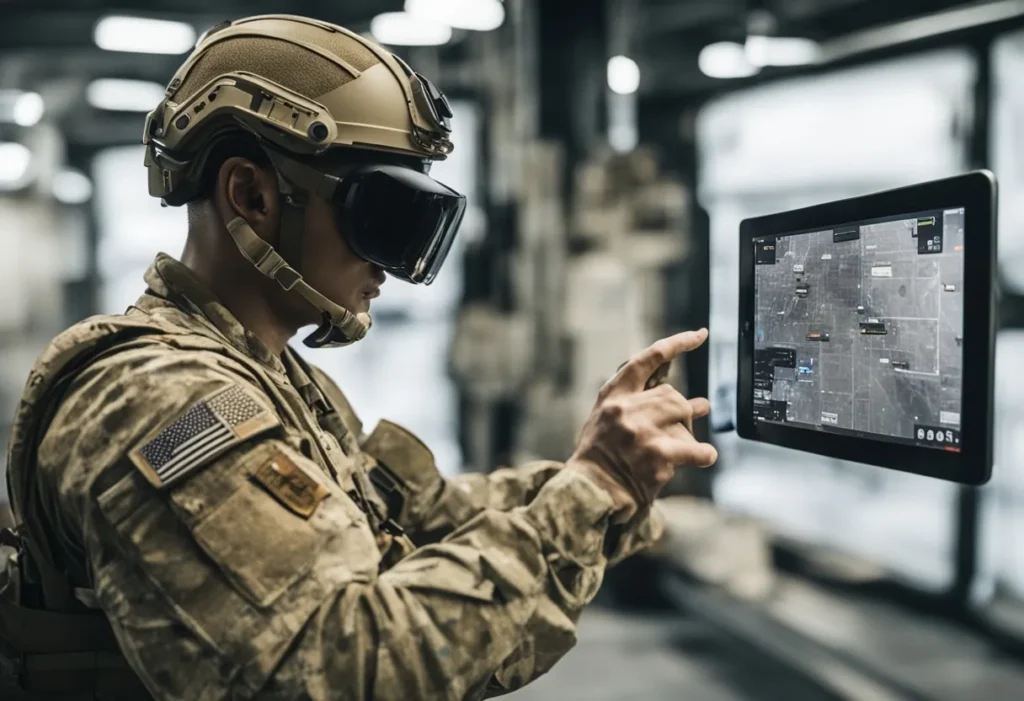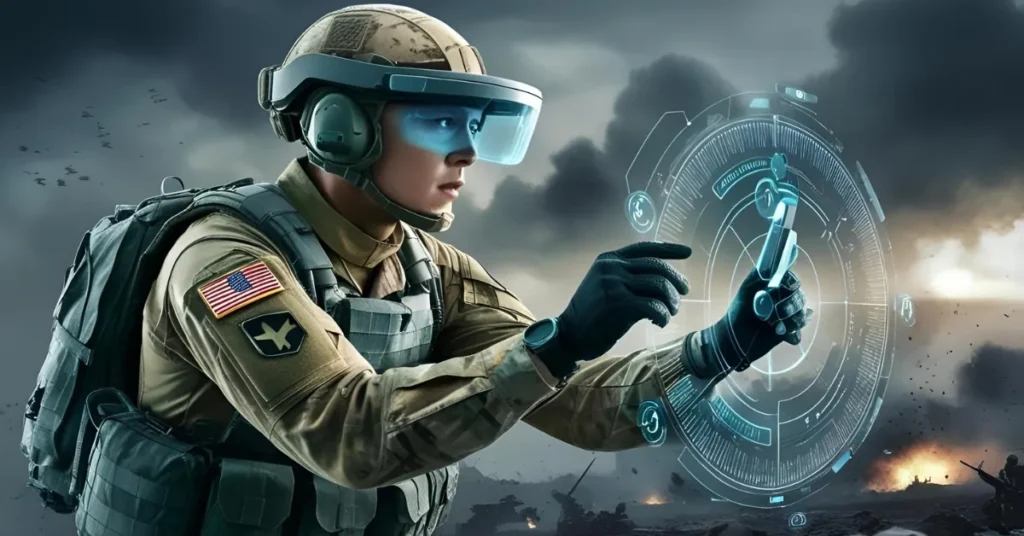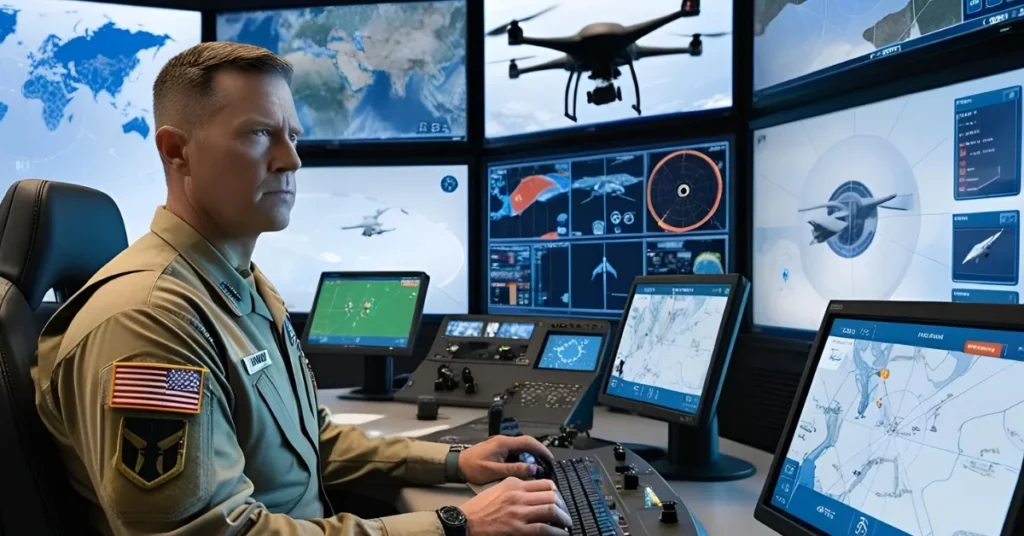AR in military and defense is flipping the script on how soldiers train, fight, and win.
I’m diving into why this tech is a game-changer, how it’s being used, and what it means for the future.
If you’re wondering how augmented reality is making soldiers sharper and battlefields smarter, stick with me.

Why AR in Military and Defense Matters
Let’s be real – warfare is brutal, complex, and unforgiving.
Soldiers need every edge to stay alive and get the job done.
That’s where AR in military and defense comes in, blending digital info with the real world to make split-second decisions easier.
Think of it like a heads-up display in a video game, but for life-or-death situations.
I first got hooked on this topic reading about the U.S. Army’s IVAS (Integrated Visual Augmentation System).
It’s a rugged Microsoft HoloLens that overlays maps, enemy positions, and weapon stats right in a soldier’s field of view.
No more fumbling with paper maps or clunky GPS devices – everything’s right there.
Here’s why this tech is blowing up:
- Real-time data: Soldiers see enemy locations, terrain details, and friendly positions instantly.
- Training on steroids: AR simulates combat scenarios so real, you’d swear you’re in the fight.
- Less collateral damage: Precise info cuts down on mistakes like friendly fire or civilian casualties.
How AR Is Used in Military and Defense
AR in military and defense isn’t just sci-fi hype – it’s being rolled out now.
From training grounds to battlefields, here’s how it’s making waves.
1. AR Training Simulations for Soldiers
Training used to mean firing ranges and sweaty obstacle courses.
Now, AR training simulations for soldiers create virtual battlefields that feel like the real deal.
I read about the U.S. Army using AR at Fort Moore to simulate urban combat.
Soldiers wear headsets that overlay enemies, explosions, and objectives onto a real training ground.
Why it’s awesome:
- Safe but intense: Practice life-or-death scenarios without real bullets.
- Custom scenarios: Train for anything – jungle ambushes, desert raids, or city fights.
- Instant feedback: AR tracks your moves and tells you where you screwed up.
Example: The Synthetic Training Environment (STE) by the U.S. Army lets squads train together in virtual worlds.
It’s like Call of Duty, but you’re learning to save lives.

2. AR for Battlefield Visualisation
On the battlefield, information is king.
AR for battlefield visualisation gives soldiers X-ray vision (kinda).
Headsets like the IVAS show real-time intel – enemy positions, drone feeds, even thermal imaging.
Picture this:
You’re a soldier in a chaotic urban fight.
Your AR headset pings an enemy sniper 200 meters away, marks their position, and suggests a safe route to flank them.
That’s the kind of edge AR for battlefield visualisation delivers.
Pro Tip: Check out Janes for the latest on defense tech like IVAS. They’ve got detailed breakdowns on military gear.
3. Night Vision & Tactical AR Glasses
Night ops are a whole different beast.
Night vision & tactical AR glasses combine classic night vision with AR overlays for next-level clarity.
These aren’t your grandpa’s goggles – they show enemy markers, terrain data, and even weapon status in pitch-black conditions.
I saw a report on Defense News about the Enhanced Night Vision Goggle-Binocular (ENVG-B).
It pairs night vision with AR to let soldiers “see” through smoke, fog, or darkness while tracking targets.
It’s like having superpowers.
Why they rock:
- Low-light dominance: Spot enemies in total darkness.
- Integrated data: AR overlays show friendly positions and objectives.
- Lightweight: Newer models are way less bulky than old-school night vision.
4. Maintenance and Logistics
AR isn’t just for shooting – it’s for fixing stuff too.
Military gear is complex, and downtime can cost lives.
AR overlays step-by-step repair guides onto tanks, jets, or rifles.
I saw a demo from PTC where technicians used AR glasses to repair a fighter jet engine.
The glasses highlighted bolts, showed torque настройки, and even warned about potential errors.
Result? Faster repairs, fewer mistakes, and jets back in the sky.
5. Medical Training and Combat Medics
Combat medics are heroes, but their job is insane – patching up wounds under fire.
AR in military and defense trains them in hyper-realistic scenarios.
Think virtual gunshot wounds or IED injuries you can “treat” with AR tools.
The U.S. military uses AR apps like Tactical Combat Casualty Care to drill medics.
It’s intense, but it saves lives when the real thing hits.

AR vs. VR in Military and Defense
You might be thinking, “Isn’t VR the same thing?”
Nope. Let’s break it down:
- AR (Augmented Reality): Overlays digital info on the real world. You still see your surroundings, but with extra data. Perfect for battlefields and live training.
- VR (Virtual Reality): Fully immersive, blocks out the real world. Great for simulations or planning but useless in actual combat.
Example: AR for battlefield visualisation lets a pilot see targeting data on their visor mid-flight.
VR puts them in a flight simulator on the ground.
Both are dope, but AR is the battlefield MVP.
For more on this, Takeaway Reality has a killer article comparing AR and VR in defense.
Challenges of AR in Military and Defense
Nothing’s perfect, and AR in military and defense has some hurdles.
Here’s the real talk:
- Weight: Soldiers already carry 25kg of gear. Night vision & tactical AR glasses need to be light or they’ll be a pain in the neck (literally).
- Battery life: No one wants their headset dying mid-mission.
- Cost: High-tech gear ain’t cheap. The U.S. spent billions on IVAS alone.
- Cybersecurity: Hackable AR systems could feed false info to soldiers. Scary stuff.
I chatted with a defense contractor buddy who said the weight issue is the biggest gripe.
Soldiers love the tech but hate feeling like they’re wearing a brick on their head.
Companies like Northrop Grumman are working on lighter, tougher designs.
Free Tools and Resources for AR Enthusiasts
Want to geek out on AR in military and defense?
Here are some free tools and sites to get you started:
- DefenseScoop: News on the latest military tech, including AR.
- Army Technology: The U.S. Army’s blog on cutting-edge gear.
- Unity Learn: Free tutorials on building AR apps. Great for beginners.
- Blender: Free 3D modeling software to create AR assets.
Pro Tip: Use Unity to mess around with AR training simulations for soldiers.
I built a basic battlefield overlay in a weekend – it’s easier than you think.
FAQs About AR in Military and Defense
Q: How do AR training simulations for soldiers work?
A: They create virtual enemies, objectives, and environments for soldiers to train in. It’s like a video game but with real stakes.
Q: Are night vision & tactical AR glasses widely used?
A: They’re being rolled out, especially by the U.S. and NATO forces. Systems like ENVG-B are already in the field.
Q: How does AR for battlefield visualisation help in combat?
A: It overlays real-time intel like enemy positions and terrain data, helping soldiers make smarter, faster decisions.
Q: Is AR in military and defense safe from hackers?
A: Not 100%. Cybersecurity is a big concern, but militaries are investing heavily in encryption and secure systems.
Q: Which countries are leading in military AR?
A: The U.S. and China are neck-and-neck, with Israel and the UK also making big moves.
Know More
Want to dig deeper? Check out these related articles from Daytalk:
Final Thoughts on AR in Military and Defense
AR in military and defense is no longer a “what if” – it’s happening now.
From AR training simulations for soldiers to night vision & tactical AR glasses, it’s saving lives and sharpening skills.
AR for battlefield visualisation is making warfare smarter, but challenges like weight and cost remain.
Still, I’m betting on AR to redefine how wars are fought.
What do you think – game-changer or overhyped? Hit me up with your thoughts.

